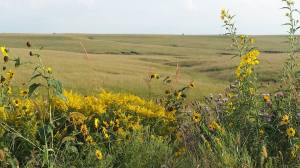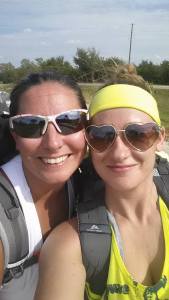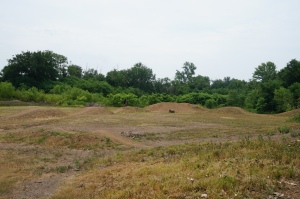We put out our Flint Hills Nature Trail Challenge, and this September, Maggie and Carrie were the first to complete it! It was actually our original challenge post that inspired their trip, which is a pretty big honor!

All photos by Maggie.
We reached out to Maggie to find out more about her trip, and here’s what we learned:
What was it that inspired you to hike the Flint Hills Nature Trail?
My research inspired me to hike the FHNT. It begins in the early spring, my obsessive need to find that perfect off the beaten path trail. By late summer/early fall I’m all set and embarking on my new journey.
I must admit though, the challenge posted for this particular trail peaked my interest. There are not many firsts in life, snatch them up while you can!
Did you have a favorite part along the way?
It’s hard to chose a favorite part of the FHNT. Every section is so diverse in its beauty. From the deep shaded forest to the picturesque prairie and all the fresh farmland in between. It makes it impossible to pick just one.
Were there any parts that needed to be worked on in terms of building?
There were some underdeveloped sections of the trail, but even those held breathtaking beauty.
I feel that the trail council, friends of the trail and all the volunteers are doing a great job maintaining and developing the trail. It takes time and money, but it will just keep getting better!
We’ve had a lot of people ask us at our readings about camping along the trail. Where were you able to spend the night while you were on the trail?
Camping along the trail is prohibited. I’m not sure if that rule will eventually change with development, but I believe trail shelters would be a major improvement. (**Side note – we agree!**) That way you could still be in control of where trail users camped, but give the hikers especially a more realistic day and mileage to cover in between.
As it stands now, anyone thru hiking this trail will have to plan accordingly to make their miles in between public campgrounds. It doesn’t leave a lot of wiggle room for mother nature, failed gear, accidents or just exhaustion.
Who would you recommend try the FHNT?
I would recommend the FHNT to anyone. This trail quickly made my top ten and is perfect for beginners and veterans alike.
How long did it take start to finish?
It took Carrie and I nine days to thru hike this trail. We had quite a time locating trailheads and safe parking that first day, putting us off to a late afternoon start and only gaining 8 miles. We walked off the trail in Herington the following Thursday around six in the evening, and headed straight to Subway!
Any hazards along the trail?
We didn’t encounter any hazards along this trail that aren’t the norm on any trail. The usual down trees, rickety bridges on the list for repairs, and wildlife with the occasional predator.
Any advice to those who want to try thru-hiking the FHNT?
My advice to anyone wanting to thru hike the FHNT would be do your research and make a plan. This trail is unique with its no camping on the trail rule. This will make your hike even more challenging and add some side miles.
GPS will become your best friend, for many miles of the trail are not marked, especially near towns.
However, the rewards of this trail definitely outweigh the obstacles.




